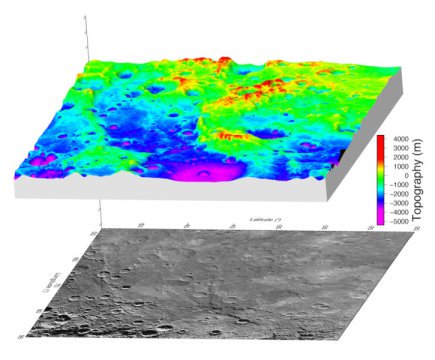Scientists have discovered a new large valley on the planet Mercury that may be the first evidence of the collapse of the planet's silicate outer shell in response to global contraction. The researchers discovered the valley using a high-resolution topographic map of part of the southern hemisphere of the planet Mercury created from stereoscopic photographs from NASA's Messenger spacecraft.

Scientists have discovered a new large valley on the planet Mercury that may be the first evidence of the collapse of the planet's silicate outer shell in response to global contraction. The researchers discovered the valley using a high-resolution topographic map of part of the southern hemisphere of the planet Mercury created from stereoscopic photographs from NASA's Messenger spacecraft.
The findings were reported in a new study published in the journal Geophysical Research Letters, a journal of the American Geophysical Union.
The most likely explanation for the existence of the great valley of the planet Hema is the collapse of the lithosphere of the planet's crust and upper mantle - in response to the global contraction of the planet Hema. say the authors of the study. Earth's lithosphere is divided into many tectonic plates, but Mercury's lithosphere is mostly built as one plate. Cooling the interior of a planet Hema caused the mass to contract and curve. In the place where the contraction forces are the greatest, the rocks of the crust were pushed up and left behind a huge valley.
"There are examples of the collapse of the lithosphere on Earth in which two tectonic plates were involved, but this is the first example of the collapse of the lithosphere of the planet Hema." said Thomas Waters, senior scientist at the Center for Earth and Planetary Studies at the Smithsonian Institution - and the Washington Space Museum, lead author of the new study.
The width of the valley is about 400 km and its depth is about 3 km below the surface of the surrounding area. The length of the valley is over a thousand km and it extends to the Rembrandt basin, one of the large young impact craters on the planet Hama.
The valley is bounded by two large fractures in the surface of the planet where one side has undergone vertical displacement relative to the other. The contraction of a hot star caused the ground surface to rise so much that it became practically cliffs surrounding the valley floor, the low elevation of which the researchers say was created by the same mechanism that created the slopes themselves.
"Unlike the Syrian-African rift on Earth, the Great Valley of the planet Hema was not created by the tearing apart of the lithosphere by tectonic plates but is the result of the global contraction of the one plate, the planet Hema." Waters said. "Although one would expect a planet to contract, we are still surprised when we find out that this is how the great valley was created, which includes a large copy fault in one of the bases of the large impact craters on the planet Hema.
The spacecraft itself already completed its mission in May 2015, but the information it sent will continue to occupy the scientists for many years.
to the notice of the researchers
More of the topic in Hayadan:

3 תגובות
Can the star collapse in on itself?
A. Ben Ner
Mercury's day is two years... it's not a 1:1 lock like our Moon. Whoever lives there will have a year in the light and after that a year in darkness. sucks….
It is not clear from the article, what is the reason for the global contraction? And does the contraction indicate the existence of gases in the depths of the planet's soil?
Another detail, since the planet is "gravitationally locked", its dark side is cold while the light side is hot.
Is it expected that the contraction will be stronger on one side, due to the difference in temperature?